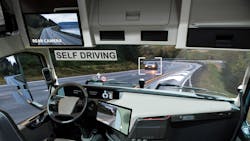Globalization accelerates automated truck technology development
Earlier this year, Knorr-Bremse announced its most recent acquisition of steering systems supplier RH Sheppard. This deal marks the latest in a line of several acquisitions and partnerships with steering system suppliers by the global commercial braking system provider over the last several years.
“To control full vehicle dynamics, which is necessary for advanced driver assistance systems as well for automated driving, there are two actuators in the vehicle, which are important: Braking, and steering,” noted Dr. Peter Laier, executive board member of Knorr-Bremse.
What Laier refers to as truck motion control, this functionality allows the braking and steering systems to communicate simultaneously and work harmoniously with one another. It’s a technology utilized on the advanced driver assistance systems on today’s heavy-duty trucks and will be the foundation for automated vehicle technologies in the future.
While acquisitions are one part of this equation, the other dynamic at play is the expanded globalization of the commercial vehicle market overall. Look no further than another acquisition finalized this year, when Traton, the commercial truck division of Germany-based Volkswagen, agreed to purchase the remaining shares of Navistar in November 2020. This will presumably allow Navistar to continue its focus on the North American market, with the support of a global parent company.
Laier noted in a conversation with FleetOwner that Knorr-Bremse, which is the parent company to the North American-based safety system supplier Bendix, made organizational changes this year to address key issues more nimbly in regional markets while still applying a modular approach to product integration on a global scale.
One example of this modular approach implemented globally has been the introduction of Knorr-Bremse’s global scalable brake control, or GSBC . This brake control system is adaptable to meet a variety of customer requirements and lays the groundwork for automated driving. For instance, the system can be implemented on trucks equipped with anti-lock braking systems (ABS) or electronic braking systems (EBS).
This is just one example. Imagine the pace at with which technology development will continue as more companies continue down this path.
Laier noted the North American market has accelerated its growth toward implementing automated technologies. This is due to advancements in legislation to test and implement this technology compared to other markets like Europe, and the demand for commercial vehicle operators due to the driver shortage.
“What we're finding now is that North America has really elevated its interest in starting to put demands into the technology portfolio in anticipation of the next generation of functioning capabilities,” Bendix President and CEO Mike Hawthorne said, regarding automated vehicle technology adoption. “It's interesting now that we are seeing the evolution of EBS over ABS, we're seeing the adoption of air disc brakes start to accelerate, and we're starting to see as we move into this next stage of automation, and electrification. The North American market is advancing at a faster pace than I think most everyone expected.”
Hawthorne attributes this faster pace to non-traditional truck OEs entering the commercial vehicle space with advanced products. “You certainly see the impact of companies like Tesla and Nikola, they have put a different type of demand interest into the fleets, and I think that is translating into higher levels of activity with OEs,” noted Hawthorne.
While sensors will monitor the truck’s surroundings and alert the driver – and ultimately intervene if the driver does not react – this is a far cry from a vehicle operating on its own. Next steps to push automated adoption will require artificial intelligence (AI) to help better disseminate the vehicle’s surroundings and make split-second decisions.
In the meantime, expect vehicle enhancements to continue at a rapid pace. That means things like ADB adoption will continue, so understanding how to service and maintain these braking systems will be imperative. Expect further adoption of electrohydraulic steering systems in commercial vehicles that utilize sensors to make finetuned adjustments to steering while in motion. Capabilities of active safety systems will continue to advance and become standard on all trucks, so fleets must train drivers to understand what every beep and button means, and train technicians to service these systems.
Ultimately, technology development on a global scale will work in concert together. The use case will be critical, however – and that can vary greatly for regional markets, not to mention the drive cycles for individual fleets. That certainly will not stop the progress from happening, but it won’t necessarily be a linear progression. It will be more of a spiderweb of technological advancement expanding toward the future.
About the Author
Erica Schueller
Editorial Director | Commercial Vehicle Group
Erica Schueller is a former editorial director of the Endeavor Commercial Vehicle Group.

